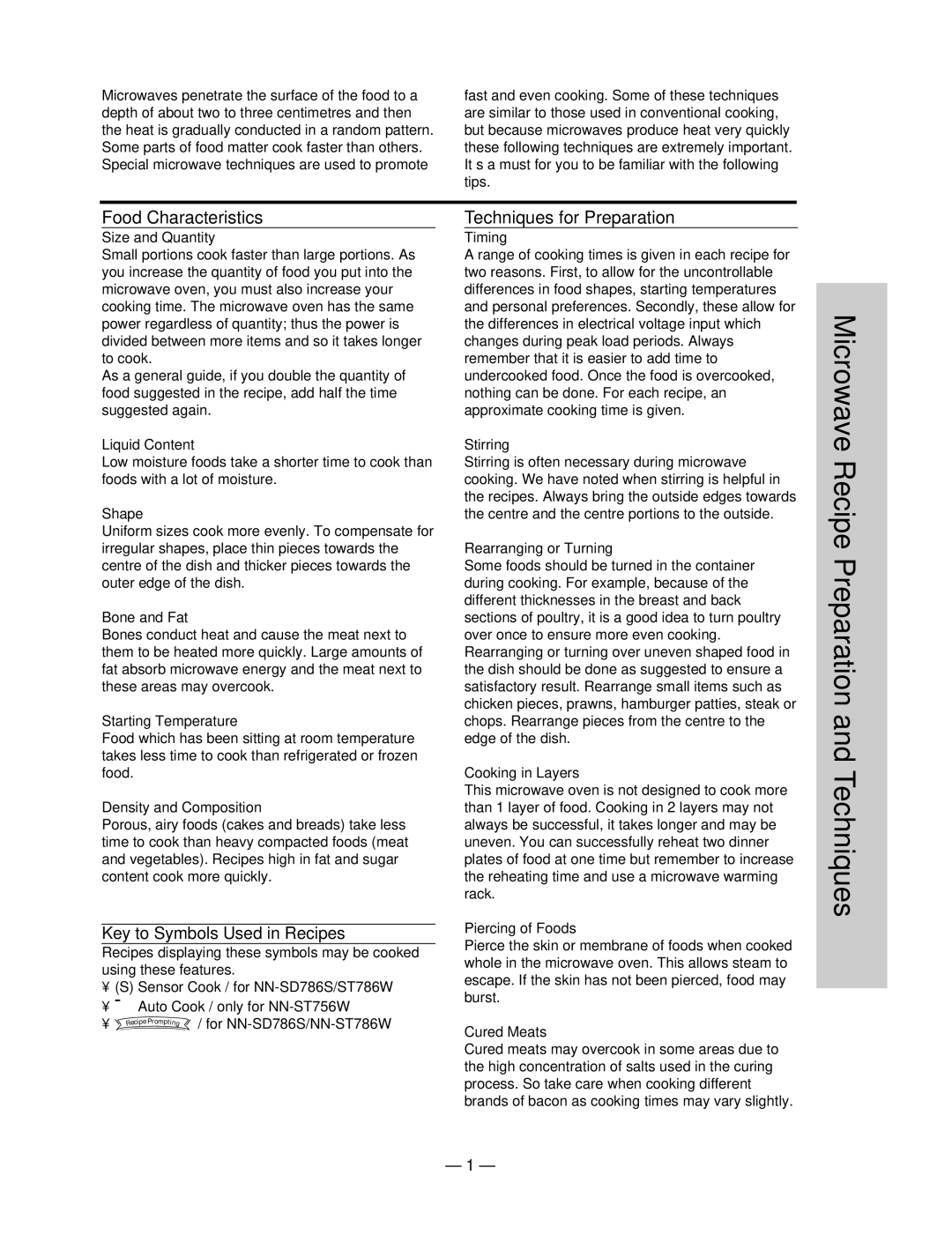Operation Guide
Important Instructions
Safety!!!!! Instructions
Read all instructions before using the microwave oven
Earthing Instructions
General Use
Installation!!!!! ! and General Instructions
Placement of Oven
Food
Microwaves!!!!! and How They Work
Cookware and Utensils Guide
Jars and Bottles
Cookware!!!!! and Utensil Guide
Plastics
Metal
Feature!!!!! Diagram
Oven!!!!!Components! Diagram
Word Prompters
Control!!!!! Panel
Start Pad
Let’s!!!!!Start To Use Your Oven
Operation Guide in the Display Window
Set Cooking Time e.g minutes
Micro Power
Power Level Wattage Example of USE
For more than one stage cooking
To!!Set!!! Clock
To Use Child Safety Lock
To cancel
Set Time of Day
To Set Delay Start
To!!Use!!! Timer Pad
To Use as a Kitchen Timer
To Set Standing Time
To!!Defrost
Set Weight
Defrost power level,page
Preparation for Freezing
Defrosting Chart by setting Micro Power at P3
Defrosting!!!!! Tips and Techniques
Defrosting Technique
More/Less Pad
Select Category
Sensor Cook
Rice or Noodles Sensor Menu Dial
Display Window and begins to count down
Sensor!!!!! Reheat
If desired, press More / Less Pad
To!!Use!!!Quick! Minute Pad
Dial!!!Features
Time Choice
To Use Recipe Prompting
To!!Use!!! Recipe Prompting
Press Rotate
To!!Use!!! Recipe! Prompting
Recipe Cook Book
Pressed 3 times
Before!!!!! Requesting! Service
Deactivated mode by pressing
After Cleaning
Technical Specifications
Before Cleaning
Care!!!!!of Your! Oven
Warranty
Panasonic!!!!! !! Technics
Feature How to Operate
Quick!!!!!Guide! to Operation
To Use Quick Minute Pad
To Cook using
To Reheat using Pads Sensor Reheat
Sensor Cook Pads S
Techniques for Preparation
Food Characteristics
Microwave Recipe Preparation and Techniques
Browning
Covering
Covering food minimizes the microwave cooking time
Standing Time
Cooking for One
Menu Planning for Microwave Cooking
Increasing & Decreasing Recipes
Converting Recipes from Other Sources
To Operate Press then Press Start
General rules for reheating foods by Micro Power
Reheating by Sensor Cook S 125 g 1.0 kg
Reheating by Micro Power Frozen Pre-cooked Foods
Reheat
Large Volume
Starting Temperature
Volume
Ingredients
Soups and Snacks
Hints
Method
Laksa
Tip
Ingredients Soup
Method Soup
Tomato pesto
Hint
Filling Corn & bacon
Fish and Shellfish
Cooking Fish and Shellfish by Micro Power
Fish or Shellfish Amount Power APPROX. Cooking Time
Directions for cooking fish by Sensor S / Auto Cook Å
40 g Butter Onion, diced ⁄4 cup Flour Tablespoon
Bouillabaisse
Noise
⁄2 teaspoon Pepper Prepared mustard 11⁄2 cups Milk 440 g
To cook by Sensor Cook / Auto Cook
Cooking Poultry by Micro power
Cooking Whole Poultry by Micro power
Cooking Poultry Pieces by Micro power
Poultry
Cooking Whole Chicken by Sensor Cook S
Cooking Eggs by Micro Power
Poultry and Eggs
Cooking Chicken Pieces by Sensor Cook S / Auto Cook Å
Ingredients 500 g
Honey Mustard Glaze
Spicy Chicken Curry
Cooked BBQ chicken
Cup Chicken stock ⁄4 cup Coconut cream
Cooking meat by Micro power
Cooking Tender Cuts of Meat using Micro power
Cooking Less-Tender Cuts of Meat using Micro power
Meat Power APPROX. Cooking Time
To Operate for Auto Cook to Curries
Cooking Curries by Sensor Cook S Auto Cook Å 250 g 750 g
General Guide to Curries For Sensor Cook / Auto Cook
Cooking Casseroles by Sensor Cook
To Operate by Sensor Cook
Method Meat Sauce
Ingredients Meat Sauce 500 g
Cheese Sauce
Combined. Cook on P7 for 7 to 9 minutes, stirring
500 g Teaspoon 425 g Cup
Beef stock cube 200 g Sliced mushrooms ⁄3 cup Sour cream
On P7 for 3 to 4 minutes. Stir through sour cream
Vegetables and Legumes
Cooking Fresh Vegetables by Micro power
Vegetable Quantity Cooking Procedure Time
Approx
Legumes
Cooking Frozen Vegetables by Micro Power
Vegetable Quantity Cooking Procedure Cooking Time
Vegetables
Chickpea Salad with Coriander Dressing S Å
Cooking Dried Beans and Peas by Micro power
Cooking Legumes by Sensor Cook S Auto Cook Å
Lentil Hot Pot S
750 g Peeled and sliced potatoes 250 ml Cream ⁄4 cup Milk
Bacon rashers, chopped ⁄2 cup Grated cheese
Tablespoon Butter 125 g Ham, finely chopped Salt and pepper
Ardennis Style Potatoes
500 g Cabbage, shredded Tablespoons Water
Green onions, finely chopped
Teaspoon Dill or basil Sugar
Tablespoons Butter Salt and pepper
250 g Brussels sprouts Tablespoons Butter 150 g
Tomato, diced
Cooking Rice by Sensor Cook S / Auto Cook Å
Cooking Rice by Micro power
Rice, Pasta and Noodles
APPROX. Time Amount To Cook Rice Standing TAP
Pasta
Noodles
Cooking Pasta by Micro power
Rice, Pasta
Fresh Pasta 250 g 625 g
To cook by Sensor Cook/ Auto Cook
250 g Penne Cups Boiling water ⁄2 cup
Prepare Pasta as above. Refer to Pasta directions on
Cooking Fresh Noodles by Sensor Cook S / Auto Cook Å
Cooking Dried Noodles by Micro power
Pasta and Noodles
APPROX. Time Amount To Cook Noodles Container Boiling
To cook Noodles by Sensor Cook / Auto Cook
Cakes, Desserts and Slices
Cooking Desserts by Sensor Cook S
11⁄3 cups Milk 300 ml Cream Brown sugar
⁄3 cup Sultanas ⁄4 cup Rum 70 g
Slices fruit loaf
Variations
100 g Butter Cup Sultanas Brown sugar Milk Egg, beaten Cups
Icing
300 g Dark chocolate 400 g
Through Christmas Pudding
Makes 24 x 8 cm loaf tin
250 g Mixed dried fruit 440 g
Topping
To prepare topping
Slices
Cooking Fruit by Micro Power
Cakes
Jars and Bottles
Precautions
Preserving
Sterilizing Jars
Sauces
Heat on P10 for 1 to 2 minutes. Add milk and sugar
Cup Water To 2 teaspoons Instant coffee
Pour water into a heatproof cup. Add coffee. Stir
If desired. Stir

